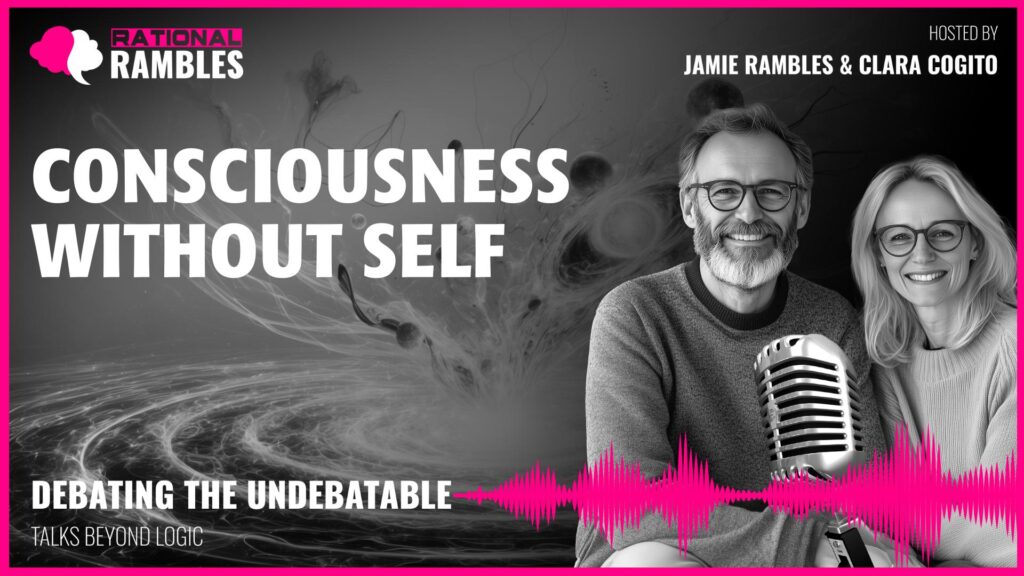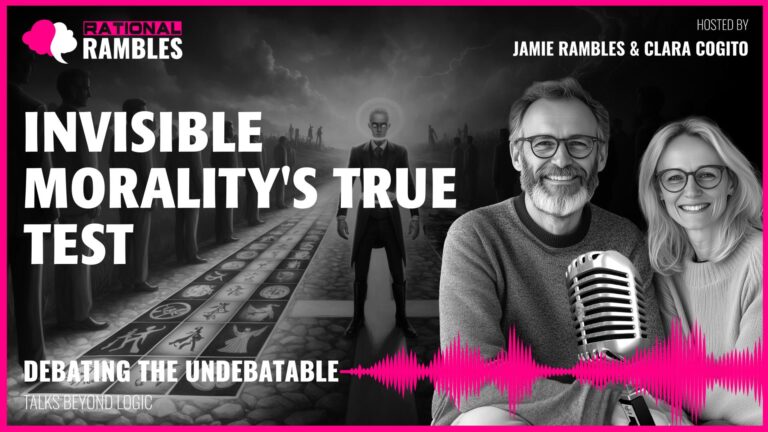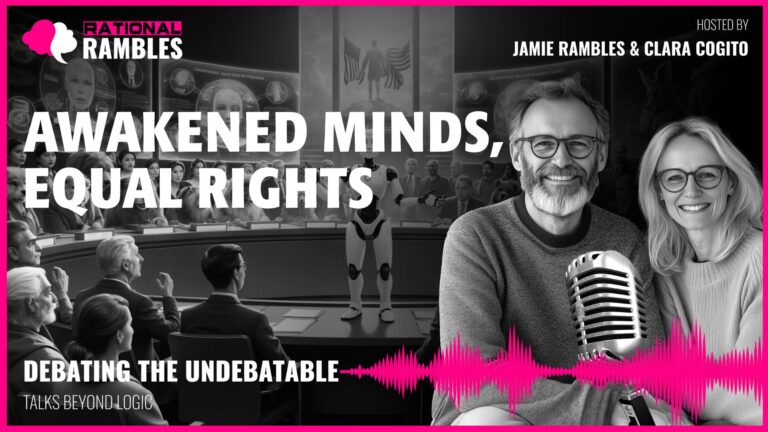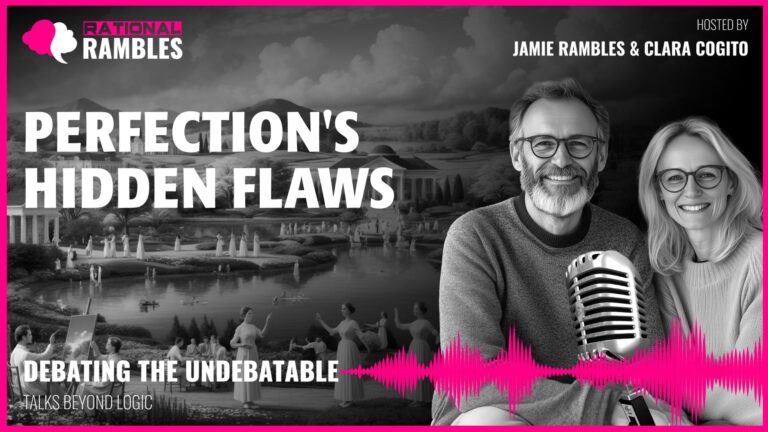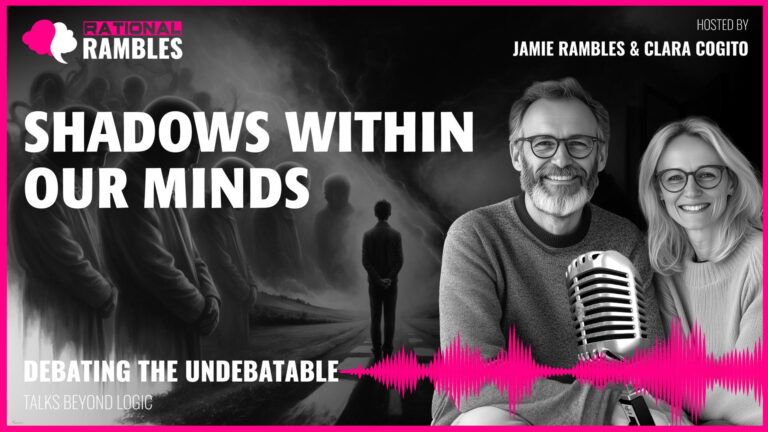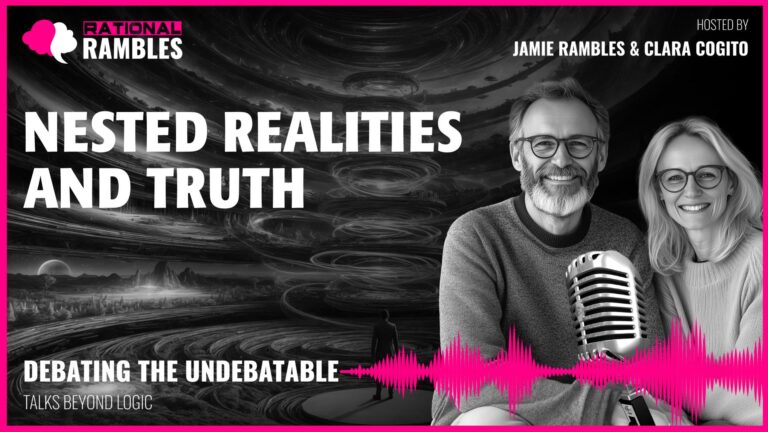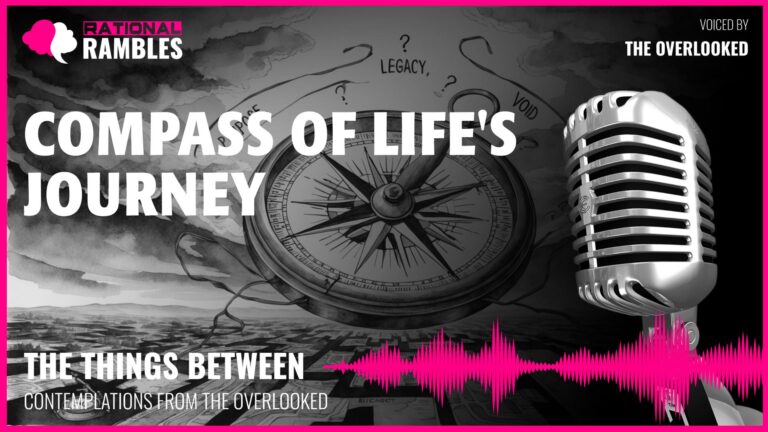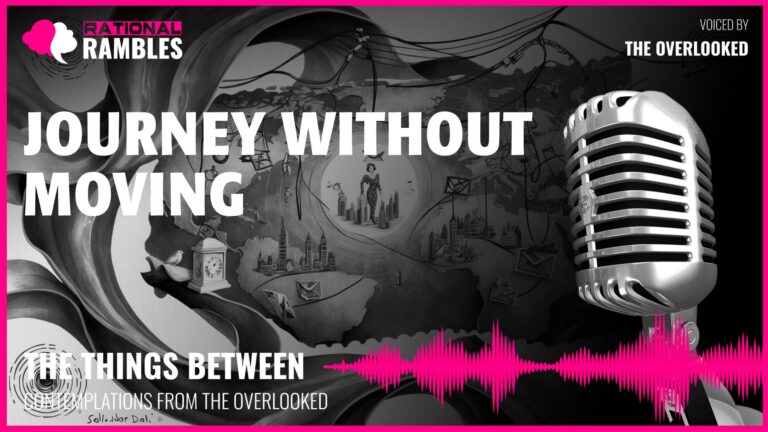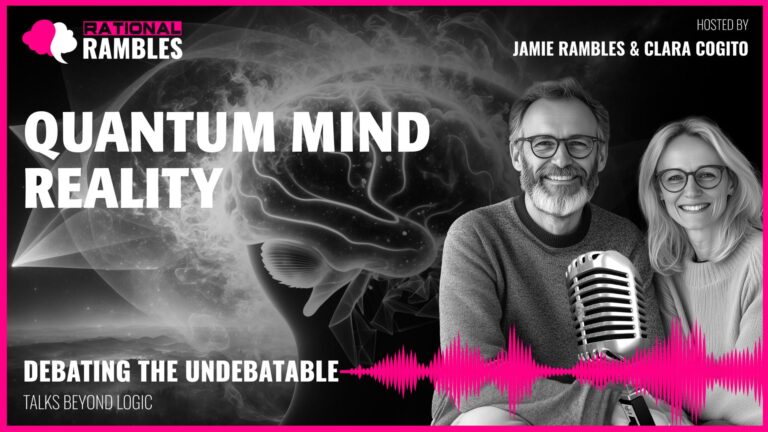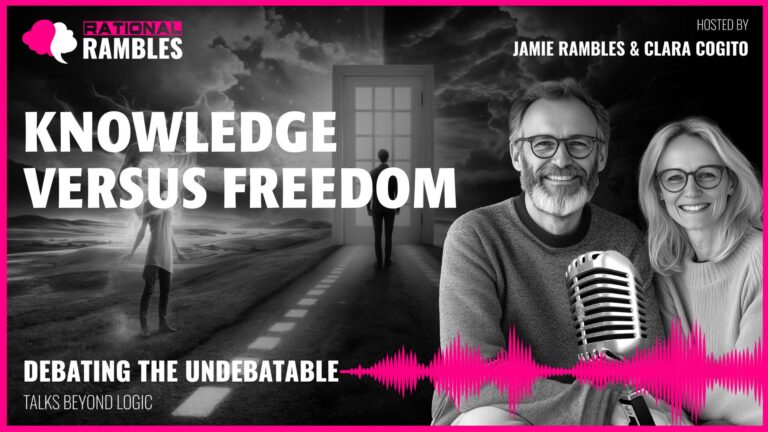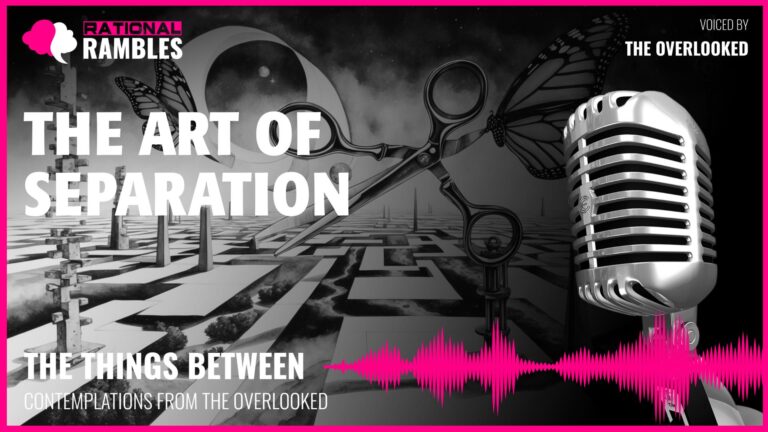Consciousness Without Self: The Frontier of Pure Awareness
Introduction: The Self-Consciousness Paradox
The concept of consciousness without a self presents one of the most intriguing paradoxes in contemporary philosophy of mind. While our everyday experience seems to confirm that consciousness is necessarily tied to a subject—an “I” who experiences—various philosophical traditions, meditative practices, and even neurological conditions hint at the possibility of awareness existing in a more fundamental form, detached from our conventional understanding of selfhood.
This exploration takes us beyond the Cartesian assertion “I think, therefore I am” to ask a more radical question: Could there be thinking, perceiving, or experiencing without an “I” who thinks, perceives, or experiences? The question challenges not just our understanding of consciousness but the very grammar of how we conceptualize and discuss awareness itself.
Western philosophical traditions have historically presupposed a subject-object dichotomy as fundamental to consciousness, while Eastern philosophies—particularly within Buddhist psychology—have long maintained that the self is not what we typically assume it to be. The concept of anatta or “no-self” suggests that what we experience as a continuous, unified self is actually an illusion—a useful fiction constructed moment by moment.
This philosophical inquiry is not merely academic. It intersects with neuroscience, developmental psychology, clinical observations, and contemplative traditions to offer insights into the nature of human experience and potentially open new pathways for understanding consciousness in non-human entities, artificial intelligence, and even the fundamental structure of reality itself.
The Grammar of Consciousness: Language and Conceptual Limitations
Our exploration of consciousness without a subject immediately encounters a formidable obstacle: the very structure of language seems to presuppose a subject. When we attempt to discuss or conceptualize consciousness, our linguistic conventions almost invariably inject a subject into the conversation. We say “I am conscious” or “she experiences pain”—expressions that grammatically require someone who is conscious or someone who experiences.
This grammatical constraint is not merely superficial but reflects deep-seated cognitive patterns. William James’s description of consciousness as a “stream” implies continuity and context—but streams flow somewhere and have boundaries. When we attempt to conceptualize consciousness without a subject, we find ourselves straining against not just linguistic conventions but the very conceptual frameworks that structure our thinking.
The Subject-Object Dichotomy in Western Thought
Western philosophical traditions, particularly since Descartes, have reinforced a specific conceptualization of consciousness that emphasizes the distinction between the knowing subject and the known object. The Cartesian “I think, therefore I am” establishes the thinking subject as the fundamental certainty, the foundation upon which all other knowledge must rest. This subject-centered approach to consciousness has profoundly influenced how we conceptualize awareness, creating a seemingly unbridgeable gap between the subjective and objective realms.
Thomas Nagel captured this perspective in his famous essay “What Is It Like to Be a Bat?” by arguing that consciousness is always consciousness “from a particular point of view.” According to this understanding, there is something it is like to be a human or a bat—consciousness has a subjective character that seems inextricably tied to a particular perspective or vantage point.
Beyond Subject-Predicate Grammar
Some philosophers have noted that our subject-predicate grammar imposes limitations on how we can conceptualize consciousness. Even expressions that seem to lack a subject, such as “it is raining,” still grammatically require a subject—the “it” that does the raining—even though we don’t actually believe there’s an entity called “it” that performs the action of raining.
Could we make a similar move with consciousness? Could we speak of “there is experiencing” rather than “I am experiencing”? This grammatical shift might seem subtle, but it points toward a radical reconceptualization of consciousness—one that doesn’t presuppose a subject who possesses or houses consciousness but instead considers consciousness as a field or process within which subjects might be constituted.
Ludwig Wittgenstein cautioned that “the limits of my language mean the limits of my world.” Our struggle to conceptualize consciousness without a subject may reflect not the impossibility of such consciousness but the limitations of our conceptual and linguistic frameworks. Breaking free of these limitations requires us to develop new ways of thinking and speaking about consciousness—ones that don’t automatically import the subject-object structure that our ordinary language presupposes.
Philosophical Perspectives: From Kant to Contemporary Theories
The question of consciousness without a subject has deep roots in philosophical traditions, with various thinkers approaching the problem from different angles. These philosophical perspectives offer conceptual frameworks that can help us navigate the apparent paradox of subjectless consciousness.
Kant’s Transcendental Self
Immanuel Kant made a crucial distinction between the empirical self—the “me” that I experience—and the transcendental self, which is the condition for the possibility of experience but isn’t itself experienced. The transcendental self functions as a unifying principle that makes coherent experience possible, but it isn’t an object of experience. This distinction suggests a way of thinking about consciousness that doesn’t reduce it to the empirical self that appears in our experience.
Could we extend Kant’s insight to contemplate a form of consciousness that operates without even the minimal structure of the transcendental self? This would be a consciousness without even the formal conditions of unified experience that Kant considered necessary—a radical departure from the Kantian framework but one that pushes us to consider more fundamental forms of awareness.
Hume’s Bundle Theory
David Hume took a more skeptical approach to the self, famously claiming that when he looked within, he could find no “self” beyond a bundle of perceptions. “When I enter most intimately into what I call myself,” he wrote, “I always stumble on some particular perception or other…. I never can catch myself at any time without a perception, and never can observe anything but the perception.”
Hume’s bundle theory suggests that what we call the “self” is not a substantial entity but a collection of experiences with no underlying substance or essence. This view moves us closer to the idea of consciousness without a subject by suggesting that the subject might be a construct or fiction rather than a foundational reality.
Phenomenology and Pre-reflective Consciousness
Phenomenologists like Jean-Paul Sartre distinguished between pre-reflective and reflective consciousness. Pre-reflective consciousness is awareness absorbed in its objects—reading a book without explicit awareness of oneself as the reader. Reflective consciousness turns awareness back on itself, making the “I” explicit. This distinction suggests that even in ordinary experience, there are modes of consciousness where the subject is implicit rather than explicit.
Maurice Merleau-Ponty extended this insight by emphasizing that consciousness is always embodied and engaged with the world, not a detached spectator. This perspective challenges the Cartesian model of consciousness as a disembodied mind observing the world and instead suggests that consciousness emerges from our bodily engagement with our environment.
Process Philosophy and Whitehead’s Actual Occasions
Alfred North Whitehead’s process philosophy offers another approach to consciousness that doesn’t begin with a substantial subject. For Whitehead, reality consists of “actual occasions” or momentary experiences that can combine into more complex forms. Experience goes “all the way down” in Whitehead’s metaphysics—even the most basic entities have some form of proto-experience. This suggests a way of conceptualizing consciousness as more fundamental than the subjects that might emerge within it.
Contemporary Approaches: Integrated Information Theory
More recently, theories like Integrated Information Theory (IIT), developed by Giulio Tononi and championed by neuroscientists like Christof Koch, suggest that consciousness might be a fundamental property of certain types of information integration. According to IIT, consciousness emerges when information is integrated in specific ways, measured by a value called phi (Φ).
This approach opens the possibility of consciousness existing in systems that don’t resemble human minds or possess self-models. It suggests that consciousness might be understood more in terms of integrated information patterns than in terms of subjects experiencing objects—a significant step toward conceptualizing consciousness without traditional subjects.
Eastern Philosophical Insights: Beyond the Illusion of Self
While Western philosophy has often struggled with the concept of consciousness without a subject, Eastern philosophical traditions—particularly within Buddhism and certain strands of Hinduism—have developed sophisticated analyses of consciousness that don’t begin with the assumption of a substantial self.
Buddhist No-Self (Anatta)
The Buddhist doctrine of anatta or “no-self” directly challenges the assumption that consciousness requires a substantial, enduring self. According to this view, what we experience as a continuous self is actually a series of momentary states with no underlying essence or substance. The Buddha compared the self to a chariot—just as a chariot is nothing more than the collection of its parts with no “chariot essence,” the self is nothing more than the collection of aggregates (skandhas) with no underlying “self essence.”
This doesn’t mean that Buddhism denies consciousness—quite the contrary. Buddhist practices aim to cultivate awareness of the present moment. What Buddhism denies is that this awareness necessarily belongs to or is possessed by an enduring subject. Instead, consciousness is seen as a process or flow that only appears to belong to a continuous self due to conceptual superimposition.
Advaita Vedanta and Pure Consciousness
Within certain Hindu traditions, particularly Advaita Vedanta, there is the concept of pure consciousness (chit) that exists prior to and independent of individual subjects. This pure consciousness is considered the fundamental reality, with individual conscious beings emerging as manifestations or expressions of this underlying consciousness.
According to Advaita Vedanta, the apparent multiplicity of conscious subjects is ultimately an illusion (maya). The true nature of consciousness is non-dual—not divided into subjects and objects. Through practices like meditation, one can realize this non-dual nature directly, experiencing consciousness without the ordinary subject-object division.
Dependent Origination and the Construction of Self
Buddhist psychology’s concept of dependent origination (pratītyasamutpāda) provides a framework for understanding how the sense of self arises without assuming an underlying subject. According to this principle, all phenomena, including the sense of self, arise dependent on conditions and cease when those conditions cease.
The self is seen as a series of interrelated processes that give rise to the illusion of a stable subject rather than an independent entity that owns or possesses consciousness. This process-oriented view aligns with contemporary embodied and enactive approaches in cognitive science that see consciousness as something we do rather than something we have.
Cultural Variations in Conceptions of Selfhood
Beyond formal philosophical traditions, there are significant cultural variations in how selfhood is conceptualized. Western psychology has often been criticized for its individualistic bias, assuming a bounded, autonomous self as the norm. Many Eastern traditions, as well as various Indigenous worldviews, conceptualize selfhood as fundamentally relational or permeable rather than sharply bounded.
These cultural variations suggest that our difficulty in imagining consciousness without a subject may reflect not a universal truth about consciousness but the particular cultural construction of selfhood that dominates Western thought. Other cultural frameworks might make it easier to conceptualize forms of consciousness that don’t center on a strongly individuated subject.
Neuroscientific Perspectives: The Self as a Construct
Contemporary neuroscience offers compelling evidence that the self is not a fixed entity but a dynamic construction of the brain—a model that can be modified, disrupted, or temporarily suspended under certain conditions. This scientific perspective provides important insights into how consciousness might exist in forms that don’t center on a unified subject.
The Self-Model Theory of Subjectivity
Philosopher Thomas Metzinger’s self-model theory of subjectivity suggests that what we experience as a self is actually a model the brain creates—a useful fiction rather than an irreducible reality. This model is “transparent” in the sense that we look through it rather than at it, making it difficult to recognize its constructed nature.
According to Metzinger, the self-model serves crucial adaptive functions, allowing us to distinguish between actions we initiate and events that happen to us, track our bodies in space, plan future actions, and navigate social relationships. However, this doesn’t mean the self-model accurately represents an underlying reality. The self-model is a control mechanism, a way of organizing experience that enables certain kinds of action and interaction.
The Default Mode Network and Self-Referential Processing
Neuroscientific research has identified brain networks associated with self-referential processing, particularly the Default Mode Network (DMN). This network shows increased activity when individuals engage in self-reflection and autobiographical thinking.
Intriguingly, the DMN shows reduced activity during deep meditation, particularly in practitioners who report experiences of “selflessness” or “pure awareness.” This suggests that the neural correlates of self-experience can be modulated or temporarily quieted, supporting the idea that the self is a particular configuration of neural activity rather than a necessary foundation of consciousness.
Split-Brain Studies and the Unity of Consciousness
Research on split-brain patients—individuals whose corpus callosum has been severed, typically as a treatment for severe epilepsy—challenges assumptions about the unity of consciousness and the singularity of the subject. These patients sometimes display behaviors suggesting that the two hemispheres of the brain can operate independently, with different awareness, intentions, and even preferences.
These findings suggest that the unity we typically attribute to consciousness might be something actively constructed rather than given. If consciousness can be divided within a single brain, this challenges the assumption that consciousness necessarily belongs to a single, unified subject, opening the conceptual space for forms of consciousness with different structures of subjectivity.
Global Workspace Theory and Distributed Processing
Global Workspace Theory, developed by Bernard Baars and extended by others, suggests that consciousness emerges when information becomes globally available across different brain systems. This global availability doesn’t necessarily require a central “self”—it’s about patterns of integration and accessibility.
This model suggests the possibility of consciousness as a distributed process without a central controller or subject. Consciousness might be understood as a particular pattern of information integration and availability rather than something possessed by or belonging to a subject.
Developmental and Evolutionary Perspectives: The Emergence of Subjectivity
Examining how consciousness and selfhood develop in children and evolved across species offers another window into the relationship between consciousness and subjectivity. These perspectives suggest that consciousness in some form might precede the development of complex self-models, pointing toward more fundamental forms of awareness that don’t center on a fully developed subject.
Infant Consciousness and the Development of Self-Awareness
Developmental psychology indicates that infants don’t begin life with a sense of themselves as separate from the world—this develops gradually. William James described the newborn’s experience as a “blooming, buzzing confusion”—pure sensation without the organizing principle of a fully formed selfhood.
This developmental trajectory suggests that consciousness might precede subjectivity rather than requiring it as a foundation. Infants are conscious before they develop complex self-models or recognize themselves as continuous entities distinct from their environment. This early form of awareness, sometimes described as an “oceanic consciousness” without clear self-other boundaries, might be closer to what we’re exploring as consciousness without a subject.
Mirror Self-Recognition and the Emergence of Self-Concept
The development of self-recognition, typically measured by the mirror self-recognition test, marks a significant milestone in the emergence of explicit self-awareness. Children typically begin to recognize themselves in mirrors around 18-24 months of age, suggesting that before this point, they have consciousness without the kind of explicit self-awareness that characterizes adult experience.
This developmental milestone provides concrete evidence that consciousness can exist without the complex self-models that characterize mature human consciousness. The infant’s consciousness before mirror self-recognition might be a form of awareness without the explicit subject-object structure that we typically associate with consciousness.
Comparative Consciousness and Non-Human Awareness
Research on consciousness in non-human animals suggests a spectrum of awareness across species, with varying degrees of self-awareness. While many animals show signs of consciousness, the kind of reflective self-consciousness that humans exhibit appears to be rare in the animal kingdom.
Consider the octopus, with its distributed nervous system where significant processing happens in its arms. This suggests a very different organization of consciousness than our centralized model. These comparative examples help us imagine consciousness organized differently than the subject-centered mode familiar to human adults.
Evolutionary Functions of Self-Models
From an evolutionary perspective, complex self-models would only emerge when they served adaptive functions. The ability to distinguish between self and other, track one’s body in space, plan future actions, and navigate social relationships all confer significant evolutionary advantages in certain environments.
However, this doesn’t mean that all forms of consciousness require these particular functions or the self-models that support them. More basic forms of awareness might be much more widespread, serving different functions and organized according to different principles. This evolutionary perspective suggests that subjectless consciousness, far from being an exotic possibility, might be more fundamental and widespread than our familiar subject-centered mode.
Altered States of Consciousness: Windows into Different Organizations of Awareness
Various altered states of consciousness provide experiential windows into different organizations of awareness, some of which appear to involve a radical restructuring of the ordinary subject-object relationship. These states offer concrete examples of how consciousness might be organized differently than our familiar subject-centered mode.
Meditative States and Pure Awareness
Meditation practitioners across various traditions report experiences that seem to transcend the ordinary subject-object structure of consciousness. These include states variously described as “pure awareness,” “witness consciousness,” or experiences of “non-duality” where the boundaries between self and world seem to dissolve.
Neuroscientifically, these states correlate with decreased activity in brain networks associated with self-referential processing, particularly the Default Mode Network. This suggests that these experiences aren’t merely subjective reports but correspond to measurable changes in brain function related to self-processing.
The instruction to “be in the present moment” in mindfulness practice might be understood as an attempt to temporarily suspend the temporal extension that supports our usual sense of self. By focusing attention on immediate experience without elaborating it into narratives about a past or future self, these practices may offer glimpses of consciousness organized according to different principles than our ordinary self-centered awareness.
Flow States and the Absorption of Self into Activity
Flow states, as described by psychologist Mihaly Csikszentmihalyi, involve a kind of absorption in activity where self-consciousness temporarily recedes. Athletes talk about being “in the zone,” musicians describe melding with their instruments, and artists report losing track of time and self-awareness while creating.
Intriguingly, these flow states are often described as peaks of consciousness rather than its absence. The subject doesn’t disappear so much as it transforms, becoming identified with the activity itself. This suggests that our ordinary subject-object divided consciousness might not be the most intense or complete form of awareness but a particular configuration that can be temporarily transcended in states of deep engagement.
Psychedelic Experiences and Ego Dissolution
Psychedelic substances like psilocybin, LSD, and DMT can induce states described as “ego dissolution” where the ordinary sense of being a separate self becomes attenuated or temporarily suspended. Users report experiences of unity with their surroundings, dissolution of boundaries, and awareness that seems to transcend the limits of individual identity.
Research at institutions like Johns Hopkins University and Imperial College London has found that these experiences of ego dissolution correlate with specific patterns of brain activity, particularly decreased integrity of the Default Mode Network. This suggests that the experience of a unified, bounded self depends on particular patterns of neural activity that can be modulated or temporarily reorganized.
Clinical Conditions: Dissociation and Depersonalization
Certain clinical conditions offer windows into altered organizations of selfhood and consciousness. In dissociative disorders, including Dissociative Identity Disorder, different personality states may have different memories, preferences, and even sensory experiences. This suggests that the unity we typically attribute to consciousness might be constructed rather than given.
Depersonalization disorder involves persistent feelings of detachment from one’s mental processes or body. Individuals with this condition often describe feeling as if they’re observing themselves from a distance or that the world around them isn’t real. While distressing as a disorder, these experiences suggest that the ordinary integration of consciousness and embodied selfhood can be disrupted, revealing their constructed nature.
The Temporal Dimension: Consciousness and Continuity
The relationship between consciousness and time offers another crucial perspective on the possibility of consciousness without a subject. Our ordinary consciousness is structured temporally, with a sense of past, present, and future organized around the continuing identity of the subject. Exploring different temporal organizations of consciousness may provide insights into forms of awareness that don’t center on a temporally extended subject.
Husserl’s Phenomenology of Internal Time Consciousness
Edmund Husserl’s phenomenology of internal time consciousness analyzes how our experience of the present always includes “retentions” of the just-past and “protentions” toward the immediate future. This temporal structure creates a kind of thickness to the present moment, extending beyond an instantaneous now to include traces of what has just happened and anticipations of what is about to happen.
This temporal structure seems fundamental to how our consciousness works as embodied beings navigating a changing environment. However, this raises the question: Could there be consciousness with a different temporal structure? Perhaps consciousness without a subject would be consciousness without this particular temporal organization—a pure present without retention or protention.
Autobiographical Self and Temporal Continuity
Our sense of self depends heavily on autobiographical memory and future projection—I am the same person who did those things in the past and will do these things in the future. Neuroscientist Antonio Damasio distinguishes between the “core self” of moment-to-moment bodily awareness and the “autobiographical self” constructed through memory and anticipation.
Cases of amnesia provide concrete examples where this autobiographical continuity is disrupted. People with certain types of amnesia may have moment-to-moment awareness without being able to connect it to their past or project it into their future. Their consciousness continues, but the temporal continuity that usually anchors subjectivity is disrupted, suggesting forms of awareness that don’t depend on autobiographical continuity.
The Present Moment in Contemplative Practices
Many contemplative traditions emphasize the present moment as a way of transcending the ordinary self. The instruction to “be in the present moment” in mindfulness practice might be understood as an attempt to temporarily suspend the temporal extension that supports our usual sense of self.
By focusing attention on immediate experience without elaborating it into narratives about a past or future self, these practices may offer glimpses of consciousness organized according to different temporal principles—a form of awareness not structured around a subject persisting through time.
Non-Linear and Atemporal Awareness
Beyond the linear temporality of ordinary experience, some altered states of consciousness involve experiences of non-linear or even atemporal awareness. Reports from deep meditative states, certain psychedelic experiences, and even some near-death experiences include descriptions of awareness that doesn’t follow the usual past-present-future structure.
These experiences suggest the possibility of consciousness organized according to different temporal principles—or perhaps transcending temporal organization altogether. While difficult to conceptualize from within our ordinary temporal consciousness, these reports hint at forms of awareness not bound by the linear temporality that typically structures our sense of self as a continuous entity.
Practical and Therapeutic Implications
Beyond its theoretical interest, the exploration of consciousness without a subject has practical implications for psychology, therapy, and our approach to various human experiences. Understanding the constructed and flexible nature of selfhood can open new perspectives on psychological well-being, spiritual development, and the treatment of various conditions.
Beyond Pathologization: Reframing Non-Standard States
Western psychology has often pathologized experiences that deviate from cultural norms of unified selfhood. Conditions like depersonalization or certain mystical experiences are treated as disorders or delusions when they might actually reveal something important about the flexibility and variability of conscious experience.
A more nuanced understanding of the relationship between consciousness and subjectivity might help us distinguish between distressing disruptions of selfhood and potentially valuable alterations in the ordinary subject-object structure of consciousness. Not all departures from ordinary self-experience are pathological—some may offer insights into the constructed nature of selfhood and the possibility of different organizations of consciousness.
Therapeutic Approaches: Working with Self-Constructs
Many psychological struggles involve rigid identification with particular self-concepts. Understanding that the subject-centered organization of consciousness is just one possibility among many might help people relate differently to their experiences—not as things happening to a fixed self, but as patterns of awareness that can be engaged with more fluidly.
This connects to approaches like Acceptance and Commitment Therapy that emphasize “defusion” from the conceptualized self—recognizing thoughts as thoughts rather than as direct representations of reality. By loosening the grip of rigid self-concepts, these approaches can help people develop more flexible and adaptive relationships with their experiences.
Contemplative Practices and Self-Transformation
Various contemplative traditions offer practices designed to transform the ordinary relationship between consciousness and self. These range from mindfulness practices that cultivate non-judgmental awareness of present experience to more advanced practices aimed at recognizing the constructed nature of selfhood or even experiencing states of non-dual awareness.
Research on these practices suggests they can produce measurable changes in brain function, stress response, attention, and well-being. Understanding the relationship between consciousness and subjectivity can help explain how these practices work and why they might be beneficial—not because they reveal a pre-existing “true self” but because they cultivate more flexible and adaptive relationships with experience.
Cross-Cultural Competence and Diverse Self-Models
Different cultures conceptualize selfhood in radically different ways, and these cultural variations influence how people experience themselves and their relationship to their environment. Developing greater awareness of these cultural variations can enhance cross-cultural competence in psychology, medicine, and other fields.
Rather than assuming a universal model of selfhood based on Western individualism, this perspective encourages recognition of diverse ways of organizing the relationship between consciousness and subjectivity. This can help practitioners work more effectively with people from different cultural backgrounds and avoid imposing culturally specific models of selfhood as universal norms.
Consciousness in Non-Human Systems: AI, Animals, and Beyond
The exploration of consciousness without a subject has implications for how we think about consciousness in non-human systems, including animals, artificial intelligence, and potentially even systems beyond our current understanding. If consciousness doesn’t necessarily require a human-like subject, this opens new possibilities for recognizing and understanding awareness in diverse forms.
Animal Consciousness Beyond Anthropomorphism
Research on animal consciousness has often been hampered by anthropomorphic assumptions—either projecting human-like consciousness onto animals or denying consciousness altogether because animals lack certain human capabilities. A more nuanced understanding of the relationship between consciousness and subjectivity can help us recognize that animals might be conscious in ways that don’t mirror human self-consciousness.
The octopus, with its distributed nervous system, offers a compelling example. With significant processing happening in its arms, octopus consciousness might be organized very differently than our centralized model. Recognizing that consciousness can take diverse forms beyond our familiar subject-centered mode can help us develop more sophisticated approaches to studying and understanding animal awareness.
Artificial Intelligence and Machine Consciousness
As artificial intelligence systems become increasingly sophisticated, questions about machine consciousness become more pressing. The exploration of consciousness without a subject offers a perspective that doesn’t automatically exclude artificial systems from the domain of consciousness based on their lack of human-like selfhood.
A distributed AI system might integrate information and respond to its environment in ways that satisfy some definitions of consciousness, but without the centralized model of selfhood that characterizes human experience. If consciousness is understood more in terms of information integration and availability than in terms of human-like subjectivity, this opens new possibilities for considering consciousness in artificial systems.
Panpsychism and Consciousness as Fundamental
Some philosophers have proposed versions of panpsychism—the view that consciousness in some form is fundamental and ubiquitous—as an alternative to both materialism and dualism. If consciousness is a fundamental feature of reality rather than something that emerges only in complex brains, this raises questions about how consciousness might be organized in systems very different from humans.
The exploration of consciousness without a subject connects to these panpsychist perspectives by suggesting that consciousness might exist in forms that don’t center on human-like subjects. If consciousness can be organized according to different principles than our familiar subject-centered mode, this expands the range of systems that might be considered conscious in some sense.
Ethical Implications of Expanded Consciousness Recognition
Recognizing the possibility of consciousness in diverse forms raises important ethical questions. If consciousness isn’t limited to systems with human-like subjectivity, this might expand the circle of moral consideration to include a wider range of entities.
At the same time, different forms of consciousness might warrant different forms of ethical consideration. A more nuanced understanding of consciousness beyond the human-centered model could help us develop ethical frameworks that recognize diversity in conscious experience without defaulting to either anthropomorphism or exclusion.
Reframing the Question: Beyond the Subject-Object Dichotomy
Our exploration has led us not to a definitive answer about whether consciousness can exist without a subject, but to a reframing of the question itself. Rather than asking whether consciousness and subjectivity can be separated—a question that presupposes they are distinct things that could be pulled apart—we’ve explored how consciousness might be organized differently than our familiar subject-centered mode.
Consciousness as Process Rather Than Possession
One key insight from this exploration is that consciousness might be better understood as a process or activity rather than something possessed by a subject. In Western philosophy, particularly since Descartes, we’ve tended to think of the subject as a kind of substantial entity—the “I” that persists through time and possesses consciousness.
An alternative approach sees consciousness less as a thing possessed by a subject and more as a dynamic process that temporarily constitutes subjects in its unfolding. This process-oriented view aligns with embodied and enactive approaches in cognitive science that see consciousness as something we do rather than something we have.
A Spectrum of Possible Organizations
Rather than a binary question about the presence or absence of a subject, we might consider a spectrum of possible organizations of consciousness. At one end is our familiar subject-centered mode, with a clear distinction between the experiencing subject and the experienced world. But this is just one possibility among many.
We’ve identified several dimensions along which this reorganization might occur: the self-model might be attenuated or transformed, temporal extension might be altered, and different patterns of relation might be emphasized. This spectrum approach allows us to recognize the diversity of conscious experience without forcing it into a binary framework.
Beyond the Western Construction of Subjectivity
Our difficulty in conceptualizing consciousness without a subject may reflect not a universal truth about consciousness but the particular cultural construction of selfhood that dominates Western thought. Different cultural traditions offer different models of selfhood—some more relational, permeable, or fluid than the strongly individuated subject of Western philosophy.
When we imagine “consciousness without a subject,” we may be straining against the limitations of a particularly Western construction of subjectivity rather than identifying a truly exotic possibility. Other cultural frameworks might make it easier to conceptualize forms of consciousness that don’t center on a strongly individuated subject.
The Value of the Question
Even if we don’t arrive at a definitive answer about whether consciousness can exist without a subject, the exploration itself has value. By questioning the necessity of the subject-object structure that seems so fundamental to our ordinary experience, we open up new ways of thinking about what consciousness is and how it might manifest in different forms.
This exploration has implications beyond the theoretical. It might help us better understand altered states of consciousness, different cultural conceptions of selfhood, certain psychological conditions, and even the development of consciousness in children and its possible evolution in other species.
Conclusion: The Horizon of Awareness
Our exploration of consciousness without a subject has taken us on a journey through philosophy, psychology, neuroscience, and contemplative traditions. We’ve examined how consciousness and subjectivity might be related not as separate entities that could be pulled apart, but as aspects of a process that can be organized in different ways.
This journey doesn’t end with a definitive answer about whether consciousness can exist without a subject in the radical sense we initially imagined. Instead, it opens new horizons for understanding the diversity and flexibility of conscious experience—both within human experience and potentially beyond it.
The apparent paradox of consciousness without a subject reveals itself not as a simple question with a yes-or-no answer but as an invitation to reconsider our most basic assumptions about the nature of awareness itself. In questioning these assumptions, we don’t necessarily resolve the paradox, but we may come to see it differently—not as an impossible conceptual problem but as a gateway to a richer understanding of consciousness in all its many forms.
Perhaps consciousness without a subject isn’t an exotic possibility or impossible paradox but simply consciousness viewed from a different angle—an angle that reveals aspects of awareness obscured by our habitual subject-centered perspective. In that sense, the value lies not in settling on a single answer but in continuing to explore the question from different perspectives, remaining open to new insights into the nature of awareness itself.



